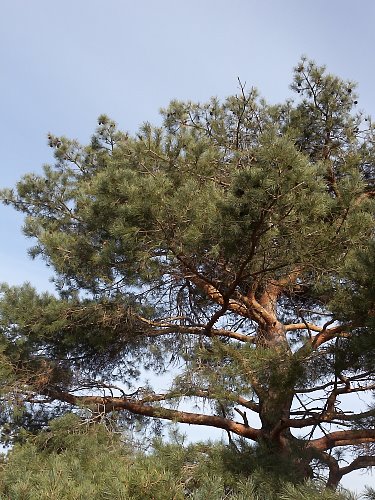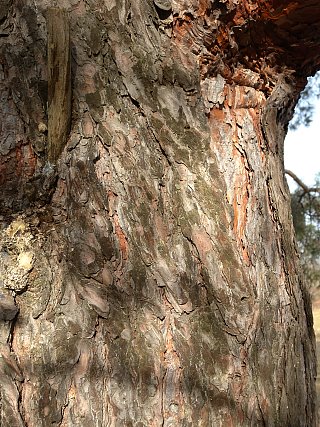Description: This tree is 40-90' tall at maturity, consisting of a single trunk and a rather broad irregular crown. The trunk is often crooked, but sometimes it is straight. The crown can be conical-ovoid to ovoid in shape with widely spreading to ascending lateral branches. The density of these branches varies with the growth of the tree. Trunk bark at the base is reddish gray and shallowly furrowed or fissured, while the thin bark of the upper trunk and major branches is orange-red and flaky. Young twigs are light brown and covered with needle-like leaves, but they become more gray and scaly in appearance with age. The needle-like leaves occur in clusters of 2 along the twigs; they are 1¼–3½" long, gray-green or blue-green, and twisted. The leaves are evergreen, remaining on the tree for 2-7 years (a shorter period of time for warm climates as opposed to cold climates). The upper surface of each leaf is slightly concave, while the lower surface is convex; there are 4-6 white lines that run along the length of the lower surface.

Scots Pine is usually monoecious, although unisexual trees occasionally occur. Pollen cones develop toward the tips of young twigs in whorled clusters. At maturity, they are yellow, ovoid in shape, and about 1/3" (9 mm.) in length. Each pollen cone consists of numerous globoid packets of pollen (microsporangia) that break open to release the pollen. At this time, the scaly seed cones are purplish red and about 1/3" (9 mm.) in length; they develop in small clusters at the tips of young twigs. Cross-pollination of the cones by wind can occur from mid-spring to early summer; it typically lasts only a few days. Afterwards, the pollen cones wither away, while the seed cones continue their development and become larger in size; this development continues into the following year. Full-sized seed cones are 1½-2½" long; they are mostly green and ovoid-conical in shape while their scales are closed, otherwise they are yellowish brown and ovoid-globoid in shape. The tips of their woody scales often have vestigial prickles, but these disappear with age. At the base of each scale, there is a pair of seeds with elongated membranous wings (up to ¾" in length). Sterile seeds are not uncommon. The seeds are distributed by the wind, primarily from late fall to early spring. The root system sometimes produces a taproot up to 10' long, otherwise it consists entirely of lateral roots that are mostly shallow and widely spreading.

Cultivation: Scots Pine prefers full sun, moist to dry conditions that are well-drained, and an acidic sandy soil, although it also adapts to other kinds of soil. Young trees usually grow fairly rapidly, while the growth of older trees is slower. Because of disease, insect pests, and climatic factors, Scots Pine can be short-lived, but at favorable sites longevity is typically 150-300 years.
Range & Habitat: Scots Pine has naturalized in only a few counties in Illinois, where it is uncommon (see Distribution Map). These naturalized populations tend to persist only in sandy areas. Typical habitats include sandy upland forests, sandy savannas, upland rocky woodlands, and open disturbed areas near cities and suburbs. Sometimes Scots Pine can be found in tree plantations and it is often used as a landscape plant. This tree was introduced into the United States from Eurasia.
Faunal Associations: Scots Pine, like other pines (Pinus spp.), is a source of food for many insects. This includes larvae of metallic wood-boring beetles, larvae of long-horned beetles, larvae and adults of weevils, larvae of bark beetles, plant bugs, stink bugs, aphids (mostly Cinara spp.), armored scales, mealybugs, larvae of pine sawflies, larvae of web-spinning sawflies, larvae of dagger-tailed sawflies, larvae of horntail wasps, larvae of Geometer moths, larvae of owlet moths, larvae of Sphinx moths (Lapara spp.), larvae of Tortrix moths, and larvae of a butterfly, the Eastern Pine Elfin (Callophrys niphon). Insects that prefer Scots Pine as a source of food include the Scots Pine Aphid (Cinara pini), Spotted Pine Needle Aphid (Eulachnus agilis), Pine Spittlebug (Aphrophora cribata), and Striped Pine Scale (Toumeyella pini). See the Insect Table for a more complete list of these insects. Vertebrate animals, particularly birds and mammals, make use of pine trees in various ways. The seeds are eaten by the Wild Turkey, Bobwhite Quail, Red-bellied Woodpecker, Mourning Dove, Black-capped Chickadee, Carolina Chickadee, Brown Creeper, Monk Parakeet (in urban areas), Red-breasted Nuthatch, White-breasted Nuthatch, Pine Grosbeak, Red Crossbill, White-winged Crossbill, Dark-eyed Junco, Pine Siskin, Common Redpoll, and Pine Warbler (Martin et al., 1951/1961; DeVore et al., 2004; DeGraaf (2002). Many birds also use pine trees for protective cover and nesting sites. Mammals that feed on these trees include the White-tailed Deer (foliage, twigs), Cottontail Rabbit (young saplings), North American Porcupine (bark, wood), White-footed Mouse (seeds), Eastern Gray Squirrel (seeds), Fox Squirrel (seeds), and American Red Squirrel (seeds); see Martin et al. (1951/1961). The Silver-haired Bat (Lasionycteris noctivagans) uses Scots Pine and other pines as roosting sites during the daytime (McGuire et al., 2012).

Photographic Location: The Arboretum of the University of Illinois in Urbana, Illinois.
Comments: This introduced pine is often cultivated because of its evergreen foliage and decorative seed cones. Large specimens of this species, in particular, have orange-red bark along the upper trunk and larger branches that is especially striking. The length of the needle-like leaves is rather variable across different specimens; young fast-growing trees tend to have longer leaves than older slow-growing trees. Different varieties of Scots Pine have been described in Eurasia; the description here applies to the typical variety (var. sylvestris). In North America, this is the variety of Scots Pine that is commonly encountered among the various cultivars. Scots Pine can be distinguished from other Pinus spp. (Pines) from a combination of the following characteristics: the color of its needle-like leaves (gray-green or blue-green), the length of its leaves (1¼-3½"), the arrangement of its leaves in clusters of 2, the length of its seed cones (1½-2½"), and the absence of conspicuous prickles at the tips of the woody scales of its seed cones. Sometimes this species is also called 'Scotch Pine.'